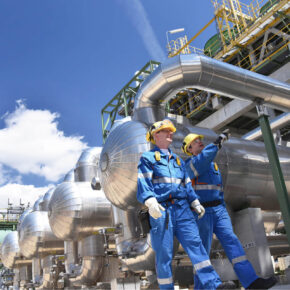
Posted on: 10. 28. 21
As much as we’d love for the oil and gas (O&G) industry to be as simple as extracting oil from the ground and sending it directly to consumers, that dream will never happen.
The truth is, there are several processes that crude oil needs to go through before it can reach the hands of consumers.
Let’s take a closer look at why crude oil needs to be refined and the exact refining process that our products have to go through before being used in a home or automobile.
Why Does Oil Have to Be Refined?
Taken directly from the source, crude oil can only really be used for burning fuel. This practice alone is a waste of a valuable resource.
So, refineries around the world essentially take a complex resource made from thousands of hydrocarbons and break it down into a usable resource through a 3 step refining process.
What Are the Steps in the Refining Process?
The refining process helps create petroleum products like gasoline, plastics, fibers, and materials for wind turbine blades. Obviously, the process is one that is integral to the O&G industry. So, let’s dive into what each step means
Separation
Separation is the process of heating up crude oil to the point that essential hydrocarbons boil off and are able to be distilled for use in future petroleum products.
Distillation units separate molecules based on their unique weights. Essentially as the unit receives the boiling crude oil, it separates it into fractions that are organized in the unit based on their boiling points. This leaves the heaviest fractions (residual fuel oil) resting at the bottom of a unit, the lightest fractions (butane) resting at the top.
Some of the most common products that directly result from separation include:
- Butane
- Kerosene
- Heavy Gas Oil
- Diesel Oil
Conversion
Conversion further refines the fractions created during the separation process. After all, even after being separated, there are still heavy molecules in the fractions that don’t allow the product to meet industry standards.
Conversion takes the fractions and uses heat, pressure, and catalysts to further “crack” the heavier molecules into lighter components that will soon become the products that consumers use on a daily basis.
Treating
Conversion still leaves molecules in petroleum products like sulfur that can result in air pollution if not treated. This part of the process further refines oils by combining different streams and removing substantial amounts of sulfur and other impurities.
Once this process is complete, the oil is considered treated. It is then stored in NGL containers where it remains safe until it is eventually moved downstream via the consumer pipelines.
How can Pro-Gas Help Your Facility Accomplish Efficient Refining?
Pro-Gas, LLC is one of the nation’s largest providers of quality O&G facility equipment. Whether you need NGL storage to move around crude/refined oils or need gas conditioners on site to help give the refining process a head start, our products help your facility meet its goals.
Contact us today to learn more about our available products in your area and how we can help your O&G team create pure, clean petroleum products for consumer use.


